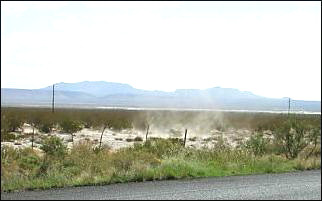

To the outsider, sandstorms may be a symbol of the desert, but to many inhabitants, that position belongs to the much more common dust devils. These whirlwinds look like miniature tornados as they lift towering columns of dust, sometimes to heights of over a mile. The Chihuahuan Desert's typical mixture of small mountain ranges separated by low-lying bolsons is ready-made for these meteorological phenomena. Breezes channeled at an angle through a gap in a mountain mass spill out onto the bolson, often interacting with the landscape to form an eddy. The bolson's hot floor heats the swirling air, causing it to rise while sweeping surrounding air and dust into the whirlwind. Loose particles from those dry lake beds called playas and from over-grazed, disturbed ranges commonly contribute to this debris that is lifted into the atmosphere.
In the heat of summer, sometimes a dozen or more dust devils move
slowly across the landscape, maintaining their identity for long minutes. Thankfully,
these little dust devils seldom cause serious damage.

Listen to the Audio (mp3 format) as recorded by KTEP, Public Radio for the Southwest.
Contributor: Robert Schmidt, Department of Geology, University of Texas at El Paso.
Desert Diary is a joint production of the Centennial Museum and KTEP National Public Radio at the University of Texas at El Paso.

A dust devil near Salt Flat, Texas. Recent summer rains have left little loose dust
to be picked up—in drier times, this would be a thick column rising high into the
sky. Photograph by A. H. Harris, August 2001. ![]()
Australian Severe Weather. Photographic series of tornados and dust devils.